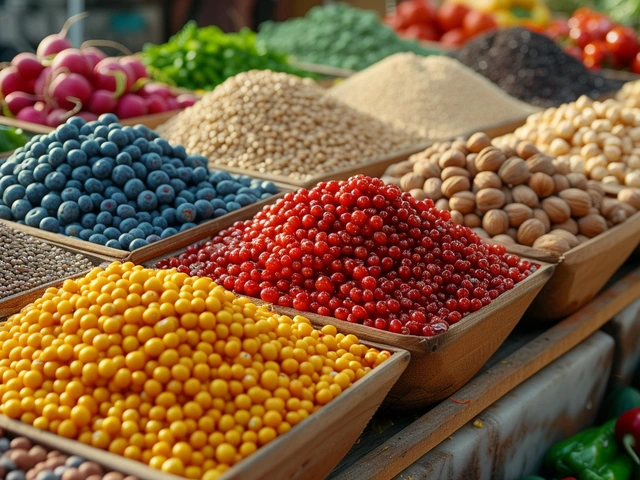Unraveling the Mystery of Biofeedback
You know how it sometimes feels like we're just dragging our fleshy bodies around like meaty luggage? Well, what if I told you there's a breakthrough that might just give us a newfangled remote control for our own personal meat-suits? Enter the realm of biofeedback, which is not some new age fad but a science-backed approach to understanding and controlling bodily functions that are usually happening backstage, without our conscious ticket admission.
So what exactly is biofeedback? At its core, it's about hooking up to sensors that give you real-time feedback on bodily functions—think heart rate, muscle tension, brainwave patterns, and more. Picture being able to watch your own stress levels rise and fall on a screen, giving new meaning to "watching your temper." It's like having a backstage pass to your body’s concert, and let me tell you, sometimes the performances of our inner workings deserve a standing ovation—or a serious tune-up.
Now, let's be real, the human body is a complicated piece of art. Each system plays its part in the grand symphony that keeps us going, and let's just say not every organ is hitting the right notes. Stress, anxiety, and a whole host of other unwanted guests can throw us out of whack. That's where biofeedback says, "Hold my protein shake," and steps in. It helps us see the invisible, and who hasn't wanted to make the invisible visible? Like when you lose your keys and wish you had x-ray vision.
The Growing Trend of Wearable Biofeedback Gadgets
These days, wearable tech is all the rage. We've got smart watches tracking our steps, apps to monitor our sleep, and even shoes that tell us if we're slacking on our running game. The trend of wearable biofeedback gadgets is like adding a mini personal trainer for your nervous system into the mix. These gizmos come in all shapes and sizes—watches that buzz when your heart rate, erm, races, headbands that calm your nerve-wracked brain, and even belts that remind you to stop stress-eating and relax your gut.
What's truly fascinating is how these gadgets are moving out of the realm of clinics and into our everyday skinscape. This isn't just for Olympic athletes or the rich and famous; it's for the average Jo(e), pacing through their day with a wristband that says, “Breathe, buddy, your heart's doing the rumba again.” But you don't need to go full cyborg to benefit from biofeedback. Sometimes it's as simple as a little clip on your earlobe, like a high-tech version of those clip-on earrings that were all the rage in the 90's, sans the fashion statement.
What's great about these devices is they're more than just glorified mood rings; they provide actual data. Because, let's be honest, we all love a good spreadsheet, especially when it's about the highs and lows of our inner workings. This data empowers us to take control, to actively participate in the care and tuning of our bodies. Plus, there's something immensely satisfying about graphs and charts that show progress—it's like getting a gold star for inner peace.
Can You Hear Your Body Talk? Biofeedback Techniques
If you thought biofeedback was all about hooking up to the Matrix, let me guide you back into the light. The techniques vary, from the sophisticated to the beautifully simple. There's the galvanic skin response, which sounds like something out of a Frankenstein novel, but it’s just about monitoring sweat and skin conductivity. Ever had clammy hands on a first date? That's your skin's way of talking, and biofeedback listens—maybe more attentively than any date you’ve had.
Then there's muscle biofeedback, which helps say “hasta la vista” to unwanted tension. Are you unknowingly clenching your jaw while reading this? There's biofeedback for that! Or breathing biofeedback to help you master the art of inhaling and exhaling like an absolute champ. This is especially fabulous because let’s face it, sometimes it feels like we forgot the user manual for even the simplest tasks like breathing.
And don't forget the power of visualizing your heartbeat. This isn't about seeing your heart pump in your eyes like in cartoons, but rather having a real-time feed of your heart's rhythm at your fingertips, which can be as calming as it is fascinating. It's like being a DJ for your own body, learning to mix and master the beats of your heart. Cue the dance music, but make it slow and soothing.
Transformative Tales of Biofeedback
They say experience is the best teacher, and in the world of biofeedback, let me tell you, the student body is diverse. I've heard stories that could fill books—like the monk who uses a headband to train his meditative states, taking chill to a whole new level. Or the lawyer who learned to reduce her migraines by monitoring her brainwaves, turning her once chaotic mind into a serene landscape of cognitive bliss.
There's also the tale of a musician who harnessed the power of biofeedback to control stage fright. By tracking his heart rate and learning to breathe through his diaphragm, he went from sweaty-palmed to standing ovations. It's like finding the cheat codes for your own body, leveling up through knowledge and self-awareness.
One of my favorite anecdotes is about a granny who conquered her insomnia through biofeedback. She went from doom-scrolling at 2 a.m. to being the queen of her own sleep cycle, and now she's doling out homemade cookies and sleeping advice like they're going out of style. It's heartwarming to see someone transform their nighttime turmoil into sweet dreams—proof that it's never too late to teach an old dog new tricks, or rather, an old body new bio-rhythms.
Emerging Research and the Future of Biofeedback
Now, I'm no fortune-teller, but when it comes to biofeedback, the future is looking brighter than my LED face mask on its highest setting. The research is buzzing like a bee with excitement. There are studies galore showing the benefits of biofeedback for everything from hypertension to anxiety, and even conditions like ADHD and PTSD. Researchers are getting all giddy with the possibilities, and who can blame them? We’re on the cusp of a revolution where personal health technology is concerned.
New developments in biofeedback might just make sci-fi buffs swoon. Imagine virtual reality settings that let you roam calming landscapes while your brainwave biofeedback tunes the experience to your inner state. Or augmented reality games that reward your relaxation skills with achievements—talk about winning at life.
All this research is adding layers to our understanding of biofeedback, transforming it into an increasingly accessible tool. This means you don't have to be a yogi or a tech wizard to get in on the action. The future of biofeedback is shaping up to be inclusive, innovative, and downright ingenious—like being able to download calmness or focus just as easily as a new playlist.
Building Your Own Biofeedback Sanctuary
Let's talk about turning your home into a biofeedback-friendly zone, because who doesn't want to be the coolest cat on their meditation cushion? Setting up your personal biofeedback sanctuary doesn't require a Ph.D. in gadgetry or turning your living room into a spaceship cockpit. It's about creating a space that promotes relaxation and self-awareness, with biofeedback tools as your trusty sidekicks.
A good place to start is identifying what you want to focus on. Is it your stress levels that have been sky-high lately? Or perhaps your sleep has been more elusive than a greased-up ferret? Once you know what you're after, you can choose your tools. Whether it's a wearable device, a smartphone app, or even a squishy stress ball that measures grip strength, make sure it's something that speaks to you.
A cozy corner of your house, a few soothing decorations, and voilà, you're well on your way to having your personal oasis. Add some ambient tunes or nature sounds, and you'll have crafted a biofeedback nook that’s as inviting as a warm hug from an old friend. Plus, it'll be a great conversation starter at parties, because let's be honest, who wouldn't want to brag about their cool new tech-savvy approach to wellness?
Navigating the Biofeedback Journey
Starting your biofeedback journey can feel like stepping into Narnia—it’s a whole new world out there. There's a flurry of information, gadgets, and techniques, and it takes a bit of adventuring to find what works for you. But fear not, because like any good quest, it comes with its rewards.
It's essential to approach biofeedback with an open mind and a dash of patience. Results don’t typically happen overnight, unless you're a fairy-tale character or have some magic beans lying around. It's a process of tuning into your body's signals, decrypting the Morse code of your physiology, and gradually gaining control. It's exciting, a bit like a personal science experiment where you're both the scientist and the lab rat.
Don't be discouraged if you don't turn into a Zen master right away. Practice is the name of the game, and every small step is progress. It's like learning to play an instrument or mastering a new recipe. And remember, it's not about perfection—it's about a deeper understanding and a healthier dialogue with your body, even if that dialogue sometimes includes asking your stomach why it thinks 2 a.m. is an appropriate time for a hunger alarm.
The Harmonious Blend of Biofeedback and Lifestyle Choices
Biofeedback isn't just a standalone traveling circus act; it harmonizes beautifully with your overall lifestyle. It's like adding nutmeg to your eggnog—it enhances the experience. Pair your biofeedback practice with healthy lifestyle choices, and you’re basically orchestrating a symphony for your well-being.
Consider your diet, sleep habits, and exercise routines as part of the equation. Biofeedback can help you understand the effects of certain foods on your stress levels or the impact of a good workout on your mood. It's about making informed decisions that lead to a happier, healthier you. It’s empowering, kind of like being the conductor of your own life orchestra.
Let's not forget the role of mind-body practices like yoga or meditation. They're like peanut butter and jelly with biofeedback—classic and synergistic. Incorporating these disciplines can help amplify the benefits of biofeedback, aligning body and mind like a beautifully choreographed dance sequence. In conclusion, biofeedback is a game-changer in the world of personal health technology. From the curious newbie to the seasoned health enthusiast, there's a biofeedback approach for everyone. It's empowering, it’s enlightening, and honestly, it's just plain cool. So grab those sensors, listen to your body's whispers (or occasional shouts), and embark on a transformative journey that tunes the body, calms the mind, and might just make you the health maestro you never knew you could be. Whether you’re looking to manage stress, improve your focus, or simply become more attuned to your body’s needs, biofeedback is a key that unlocks potential. It’s about self-improvement through self-awareness, and hey, who knew being in tune with yourself could be this much fun?





